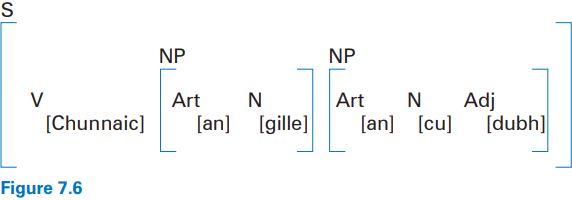


 Grammar
Grammar
 Tenses
Tenses
 Present
Present
 Past
Past
 Future
Future
 Parts Of Speech
Parts Of Speech
 Nouns
Nouns
 Verbs
Verbs
 Adverbs
Adverbs
 Adjectives
Adjectives
 Pronouns
Pronouns
 Pre Position
Pre Position
 Preposition by function
Preposition by function 
 Preposition by construction
Preposition by construction
 Conjunctions
Conjunctions
 Interjections
Interjections
 Grammar Rules
Grammar Rules
 Linguistics
Linguistics
 Semantics
Semantics
 Pragmatics
Pragmatics
 Reading Comprehension
Reading Comprehension|
Read More
Date: 11-3-2022
Date: 11-3-2022
Date: 11-3-2022
|
A Gaelic sentence
Here is a sentence from Scottish Gaelic which would be translated as “The boy saw the black dog.”

One very obvious difference between the structure of this Gaelic sentence and its English counterpart is the fact that the verb comes first in the sentence. Another noticeable feature is that, when an adjective is used, it goes after the noun and not before it. We can represent these structural observations in a labeled and bracketed diagram.

The diagram makes it clear that this Gaelic sentence is organized with a V NP NP structure, which is rather different from the NP V NP structure we found in the English sentence analyzed earlier.
It is not, of course, the aim of this type of analysis that we should be able to draw complicated-looking diagrams in order to impress our friends. The aim is to make explicit, via the diagram, what we believe to be the structure of grammatical sentences in the language. It also enables us to describe clearly how English sentences are put together as combinations of phrases which, in turn, are combinations of words. We can then look at similar descriptions of sentences in other languages such as Gaelic, Japanese or Spanish and see clearly what structural differences exist. At a very practical level, it may help us understand why a Spanish learner of English produces phrases like *the drink red (instead of the red drink), using a structural organization of constituents that is possible in Spanish, but not in English.
|
|
|
|
دور في الحماية من السرطان.. يجب تناول لبن الزبادي يوميا
|
|
|
|
|
|
|
العلماء الروس يطورون مسيرة لمراقبة حرائق الغابات
|
|
|
|
|
|
|
ضمن أسبوع الإرشاد النفسي.. جامعة العميد تُقيم أنشطةً ثقافية وتطويرية لطلبتها
|
|
|